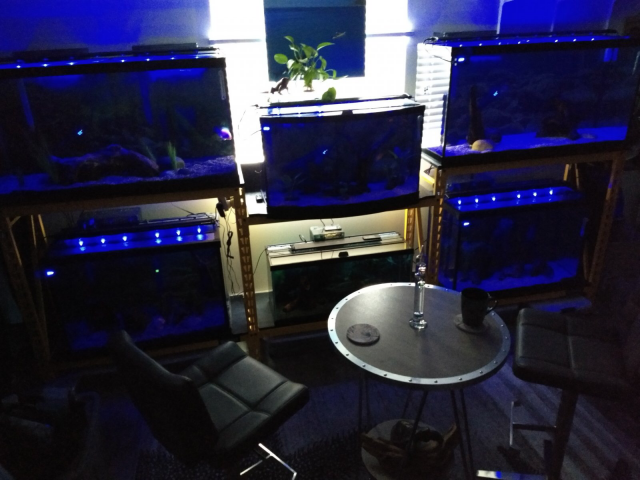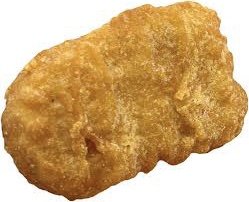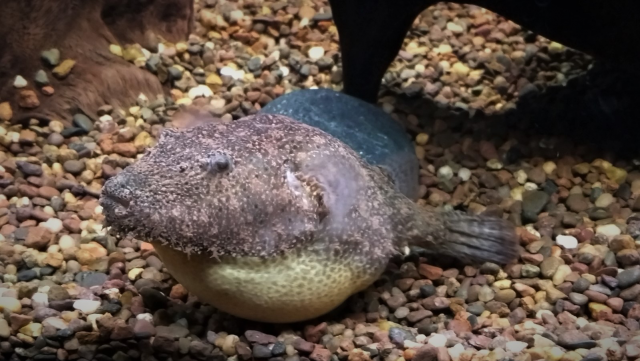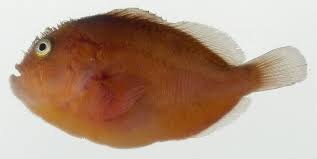I‘ve only seen one in real life. They are the cutest lil things ever! They look like chicken nuggets!
New 'hairy' monster in the house
- Thread starter DMD123
- Start date
You are using an out of date browser. It may not display this or other websites correctly.
You should upgrade or use an alternative browser.
You should upgrade or use an alternative browser.
Wow! That’s a lot. Our Brooklyn apartment can only house so much but my wife is learning about Multi tank syndrome. We added a 24 gallon bowl for her fancy goldfish and now she wants to upgrade the 55 to a 90 so her Flowerhorn will grow bigger ?
The 120 is all mine though so can do what I want. Nice that you have trimacs they are amazing.
MTS led to the current garage situation, lol

an admin asked me to check out this topic and asked if I would please comment on the 'bumblebee' oscar.
so here you are
The real 'bumblebee oscar' is Astronotus crassipinnis. Yes, Astronotus cf. obicularis used to be marketed as the bumblebee. At the time these were being distributed then that was the accepted species name and bumblebee was the hobby name that was associated with. However, because of science.. obicularis has since that time become an invalid species. A. obicularis was redescribed as A. crassipinnis. so obicularis IS crasspinnis. Same fish. Reallyu not much else to say on that. That is what it is.
While on the topic of oscars. Astronotus rubrocellatus is also no longer a valid species as they too have be reassigned and are the same fish as Astronotus ocellatus.
At this time(and its been so for some time now) only two species of oscar exist. A. ocellatus and A. crassipinnis. Aside from some minor geographical population subtleties each is fairly easy to tell one from the other. Especially when you've handled literally thousands of each species of all sizes.
Along with taking over TUIC I also took all of the rights to the 30,000+ photos Jeff had documented of every species he ever imported over 30 years. SO I have hundreds of oscar photos with locations to browse through. I havent seen anything that jumps out as "hey thats different" or at least different enough to be something entirely new or different and get me excited enough to want to go through the trouble and thousands of dollars to get a specific one in. ocellatus look like ocellatus and crassipinnis look like crassipinnis with maybe some minor color differences or a few extra or a few less spots. In 2019 I was gifted a group of massive wild crassipinnis that were Jeffs original breeding group. They were giant and very, very old. I ended up selling the group in late 2020. they looked and were no different than the current stock. he had gotten them in and marketed them way back as Astronotus obicularis rio araguaia which is now Astronotus crassipinnis rio araguaia. same fish, same river, same exporter only a decade later we had science change the name.
As far as my bumblebees being different... not very likely as they are the same fish from the same source from the same river. Juveniles however, look significantly different from adults. So when comparing my juveniles to an adult yes, they look different. my larger ones look like all other bumblebees as they should because, well.. its the same fish..
ALL, yes I said ALL of the wild crasspinnis currently being exported out of Brazil come from 1 source.
like human sibling or other relatives.. some are good looking some are uglier lol.. same with fish even within the same population. once in a private aquarium environment. care, conditions, food, all come onto play as to the appearance of the fish.
so here you are
The real 'bumblebee oscar' is Astronotus crassipinnis. Yes, Astronotus cf. obicularis used to be marketed as the bumblebee. At the time these were being distributed then that was the accepted species name and bumblebee was the hobby name that was associated with. However, because of science.. obicularis has since that time become an invalid species. A. obicularis was redescribed as A. crassipinnis. so obicularis IS crasspinnis. Same fish. Reallyu not much else to say on that. That is what it is.
While on the topic of oscars. Astronotus rubrocellatus is also no longer a valid species as they too have be reassigned and are the same fish as Astronotus ocellatus.
At this time(and its been so for some time now) only two species of oscar exist. A. ocellatus and A. crassipinnis. Aside from some minor geographical population subtleties each is fairly easy to tell one from the other. Especially when you've handled literally thousands of each species of all sizes.
Along with taking over TUIC I also took all of the rights to the 30,000+ photos Jeff had documented of every species he ever imported over 30 years. SO I have hundreds of oscar photos with locations to browse through. I havent seen anything that jumps out as "hey thats different" or at least different enough to be something entirely new or different and get me excited enough to want to go through the trouble and thousands of dollars to get a specific one in. ocellatus look like ocellatus and crassipinnis look like crassipinnis with maybe some minor color differences or a few extra or a few less spots. In 2019 I was gifted a group of massive wild crassipinnis that were Jeffs original breeding group. They were giant and very, very old. I ended up selling the group in late 2020. they looked and were no different than the current stock. he had gotten them in and marketed them way back as Astronotus obicularis rio araguaia which is now Astronotus crassipinnis rio araguaia. same fish, same river, same exporter only a decade later we had science change the name.
As far as my bumblebees being different... not very likely as they are the same fish from the same source from the same river. Juveniles however, look significantly different from adults. So when comparing my juveniles to an adult yes, they look different. my larger ones look like all other bumblebees as they should because, well.. its the same fish..
ALL, yes I said ALL of the wild crasspinnis currently being exported out of Brazil come from 1 source.
like human sibling or other relatives.. some are good looking some are uglier lol.. same with fish even within the same population. once in a private aquarium environment. care, conditions, food, all come onto play as to the appearance of the fish.
Fascinating. Thanks for the explanation. I’ve always been curious about the designation of cf obicularus and even wrote Jeff about it several years ago when I wrote a short blog on the fish for another site. Some had suggested at the time, that the name was something of a fabrication or misnomer. Though I assumed at the time obicularus to be a variant of cf. ocellatus. I concluded this in part because most available information suggested cf. Cassipinnis only grew to 10” and were generally smaller. Both DMD and my “Bumblebee” Oscars (F2 from your predecessor’s stock) were considerably larger than that, hence our tendency to differentiate ours from that species. But as per your explanation it seems far better to broaden the definition of crassipinnis, at least in terms of its size potential. For example the Wikipedia site states Crassipinnis grows up to 25 cm (10”). Clearly wrong from mine and DMD123’s experience. Science as you note gets out dated and needs updating from time to time.an admin asked me to check out this topic and asked if I would please comment on the 'bumblebee' oscar.
so here you are
The real 'bumblebee oscar' is Astronotus crassipinnis. Yes, Astronotus cf. obicularis used to be marketed as the bumblebee. At the time these were being distributed then that was the accepted species name and bumblebee was the hobby name that was associated with. However, because of science.. obicularis has since that time become an invalid species. A. obicularis was redescribed as A. crassipinnis. so obicularis IS crasspinnis. Same fish. Reallyu not much else to say on that. That is what it is.
While on the topic of oscars. Astronotus rubrocellatus is also no longer a valid species as they too have be reassigned and are the same fish as Astronotus ocellatus.
At this time(and its been so for some time now) only two species of oscar exist. A. ocellatus and A. crassipinnis. Aside from some minor geographical population subtleties each is fairly easy to tell one from the other. Especially when you've handled literally thousands of each species of all sizes.
Along with taking over TUIC I also took all of the rights to the 30,000+ photos Jeff had documented of every species he ever imported over 30 years. SO I have hundreds of oscar photos with locations to browse through. I havent seen anything that jumps out as "hey thats different" or at least different enough to be something entirely new or different and get me excited enough to want to go through the trouble and thousands of dollars to get a specific one in. ocellatus look like ocellatus and crassipinnis look like crassipinnis with maybe some minor color differences or a few extra or a few less spots. In 2019 I was gifted a group of massive wild crassipinnis that were Jeffs original breeding group. They were giant and very, very old. I ended up selling the group in late 2020. they looked and were no different than the current stock. he had gotten them in and marketed them way back as Astronotus obicularis rio araguaia which is now Astronotus crassipinnis rio araguaia. same fish, same river, same exporter only a decade later we had science change the name.
As far as my bumblebees being different... not very likely as they are the same fish from the same source from the same river. Juveniles however, look significantly different from adults. So when comparing my juveniles to an adult yes, they look different. my larger ones look like all other bumblebees as they should because, well.. its the same fish..
ALL, yes I said ALL of the wild crasspinnis currently being exported out of Brazil come from 1 source.
like human sibling or other relatives.. some are good looking some are uglier lol.. same with fish even within the same population. once in a private aquarium environment. care, conditions, food, all come onto play as to the appearance of the fish.
Not a problem at all. also, I think it is pretty safe to say no known species of oscar only grows to 10". I wouldn't really go by anything on wikipedia. Anyone can make edits so it has way too much misinformation. i wish we could find a dwarf oscar! Id sell millions of them lolFascinating. Thanks for the explanation. I’ve always been curious about the designation of cf obicularus and even wrote Jeff about it several years ago when I wrote a short blog on the fish for another site. Some had suggested at the time, that the name was something of a fabrication or misnomer. Though I assumed at the time obicularus to be a variant of cf. ocellatus. I concluded this in part because most available information suggested cf. Cassipinnis only grew to 10” and were generally smaller. Both DMD and my “Bumblebee” Oscars (F2 from your predecessor’s stock) were considerably larger than that, hence our tendency to differentiate ours from that species. But as per your explanation it seems far better to broaden the definition of crassipinnis, at least in terms of its size potential. For example the Wikipedia site states Crassipinnis grows up to 25 cm (10”). Clearly wrong from mine and DMD123’s experience. Science as you note gets out dated and needs updating from time to time.
That makes sense, Though I was just referring to Wikipedia as a example of the "popular" information available. It is important, imo, to try and create the updates on what is available to hobbyists. I have seen the reference to Crassapinnis at 10" max growth as a statement on multiple sites for years, getting repeated. Would be nice for someone to publish something on the topic of oscar species identification that is definitive and more up to date. As I am not a biologist I'm not on top of all that. If you know of an article someone has published on the topic though, I'd love to read it.Not a problem at all. also, I think it is pretty safe to say no known species of oscar only grows to 10". I wouldn't really go by anything on wikipedia. Anyone can make edits so it has way too much misinformation. i wish we could find a dwarf oscar! Id sell millions of them lol
Took the Bumblebee talk here: https://www.monsterfishkeepers.com/forums/threads/bumblebee-oscar-updates.741736/






